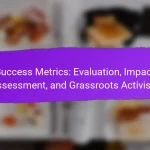Youth involvement is crucial for fostering social change and community engagement, as young people bring fresh perspectives and innovative solutions to local challenges. By participating in initiatives that align with their values, they not only empower themselves but also contribute significantly to the resilience and strength of their communities. Effective strategies for youth empowerment include opportunities for personal growth and skill development, enabling them to take active roles in shaping their environments.
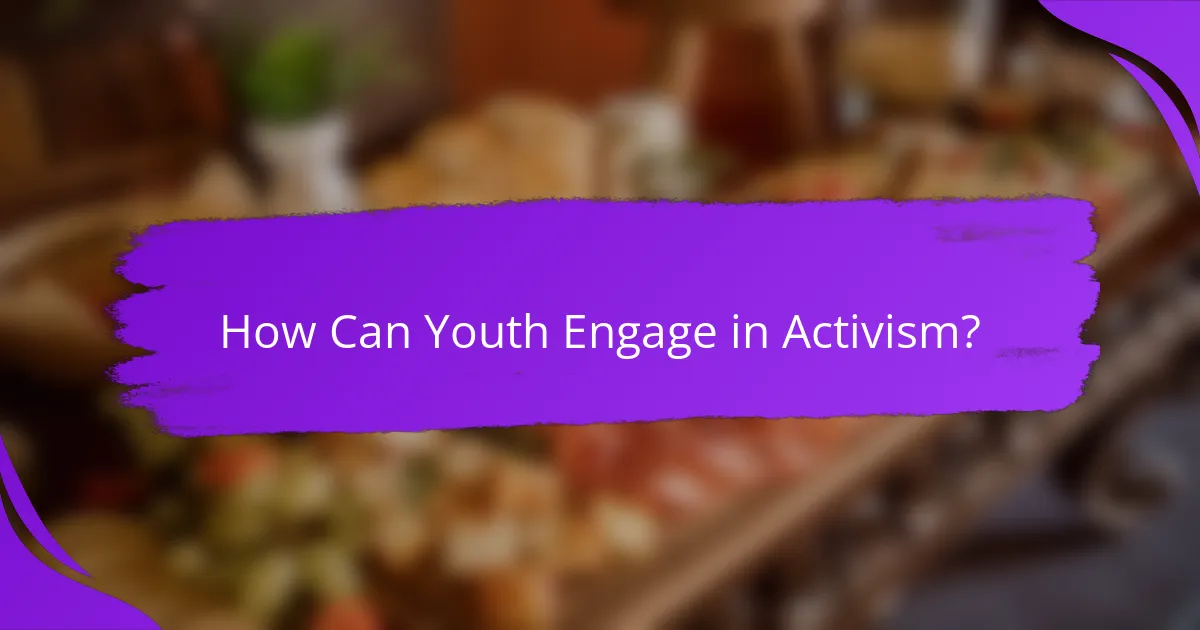
How Can Youth Engage in Activism?
Youth can engage in activism through various channels that promote social change and community involvement. By participating in initiatives that resonate with their values, young people can make a significant impact in their communities and beyond.
Community service projects
Community service projects allow youth to contribute directly to their neighborhoods while addressing local issues. These projects can range from organizing clean-up days in parks to volunteering at food banks or shelters.
To get started, youth can connect with local organizations or schools that facilitate service opportunities. It’s beneficial to choose projects that align with personal interests, as this can enhance motivation and commitment.
Social media campaigns
Social media campaigns are powerful tools for youth activism, enabling young people to raise awareness and mobilize support for causes they care about. Platforms like Instagram, Twitter, and TikTok can amplify messages quickly and reach a broad audience.
When creating a campaign, it’s essential to craft clear, engaging content and use relevant hashtags to increase visibility. Collaborating with peers can also enhance the campaign’s reach and effectiveness.
Participating in local government
Engaging with local government is a direct way for youth to influence policy and decision-making. Young people can attend town hall meetings, participate in public forums, or even run for student government positions.
Understanding local issues and the political landscape is crucial. Youth should consider reaching out to local representatives to express their views and propose initiatives that reflect their concerns.
Joining advocacy groups
Joining advocacy groups allows youth to connect with like-minded individuals and work collectively towards common goals. These groups often focus on specific issues such as climate change, education reform, or social justice.
Youth can find advocacy groups through schools, community centers, or online platforms. Active participation in meetings and events can enhance their understanding of the issues and strengthen their advocacy skills.
Organizing events
Organizing events is an effective way for youth to mobilize their peers and raise awareness about important issues. Events can include rallies, workshops, or informational sessions that educate the community and foster dialogue.
When planning an event, it’s important to set clear objectives and promote the event through various channels. Collaborating with local organizations can also provide additional resources and support.
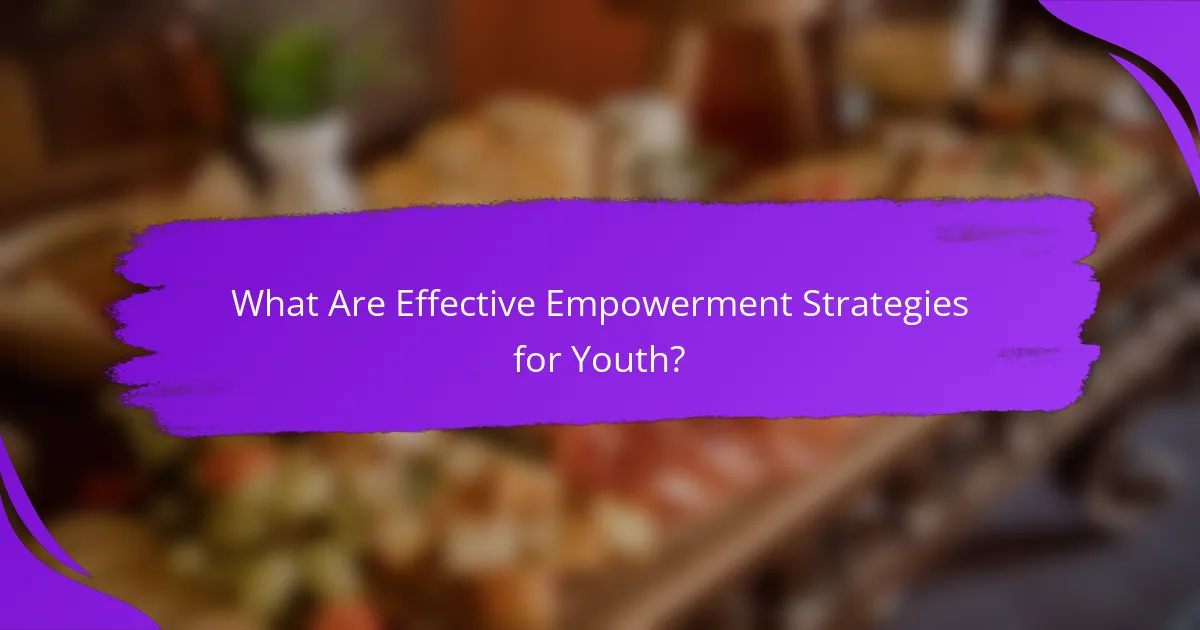
What Are Effective Empowerment Strategies for Youth?
Effective empowerment strategies for youth include providing opportunities for personal growth, skill acquisition, and active participation in community initiatives. These strategies help young individuals gain confidence, develop leadership qualities, and engage meaningfully in their environments.
Mentorship programs
Mentorship programs connect youth with experienced adults who can guide them in their personal and professional development. These relationships often foster a sense of belonging and provide valuable insights into various career paths and life choices.
When implementing a mentorship program, consider pairing mentors and mentees based on shared interests or goals. Regular meetings and structured activities can enhance the effectiveness of these relationships, ensuring that youth receive consistent support and encouragement.
Leadership training workshops
Leadership training workshops equip young people with essential skills such as communication, teamwork, and decision-making. These workshops often include interactive activities that promote self-awareness and confidence, allowing participants to practice leadership in a safe environment.
To maximize the impact of these workshops, focus on real-world scenarios and encourage participants to take on leadership roles in group projects. Offering follow-up sessions can help reinforce skills and provide ongoing support as youth apply what they’ve learned.
Skill development workshops
Skill development workshops focus on teaching specific competencies that are valuable in both personal and professional contexts. Topics can range from financial literacy and coding to public speaking and conflict resolution, catering to the diverse interests of youth.
When organizing these workshops, ensure they are hands-on and engaging. Providing resources such as take-home materials or online access to further learning can help reinforce the skills acquired. Consider collaborating with local businesses or organizations to offer real-world applications of these skills, enhancing the relevance and appeal for participants.
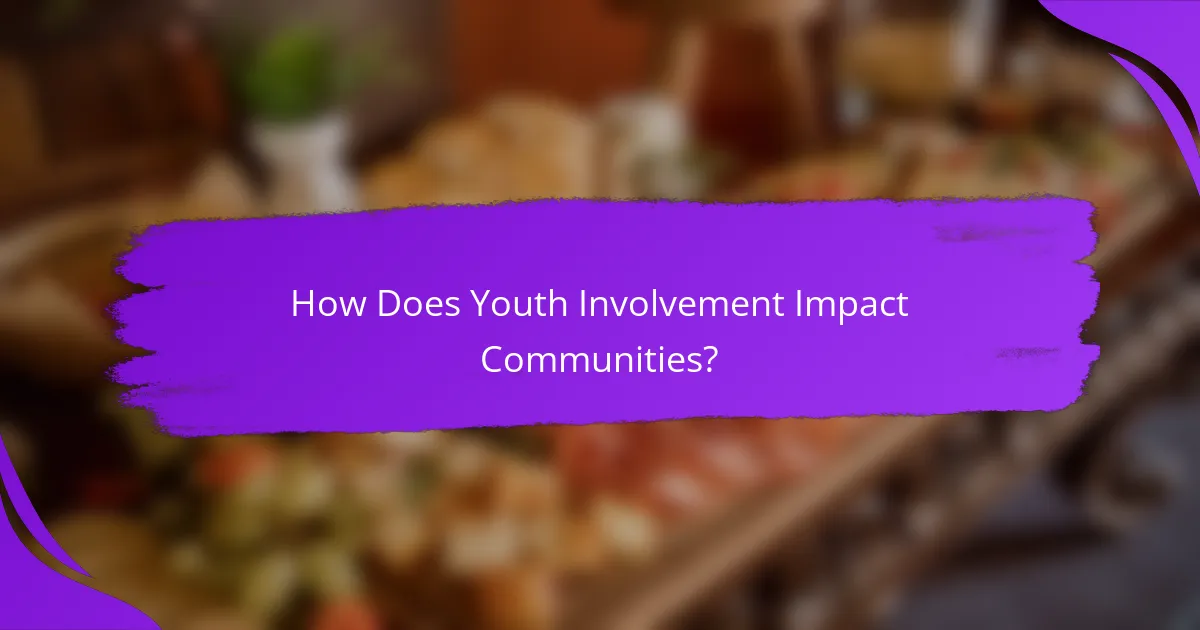
How Does Youth Involvement Impact Communities?
Youth involvement significantly enhances communities by fostering active participation, driving social change, and promoting a sense of belonging. Engaged youth contribute fresh perspectives and innovative solutions to local challenges, ultimately leading to stronger, more resilient communities.
Increased civic engagement
Youth involvement leads to higher levels of civic engagement, as young people become more aware of their rights and responsibilities. This can manifest in activities such as voting, attending town hall meetings, and participating in local governance. Communities with engaged youth often see increased voter turnout and a more informed citizenry.
To encourage civic engagement among youth, organizations can provide education on the political process and create platforms for youth voices. Programs that facilitate discussions on community issues can empower young people to take action and advocate for change.
Enhanced community services
Communities can benefit from partnerships with local schools and youth organizations to create service opportunities. By involving youth in the planning and implementation of community services, municipalities can ensure that these services are relevant and impactful.
Stronger social networks
Youth involvement fosters stronger social networks, connecting young people with peers and mentors. These networks provide support, resources, and opportunities for collaboration, which can enhance personal and professional development. Strong social ties among youth can lead to increased community cohesion and a sense of belonging.
To build these networks, communities can organize events that bring together youth from diverse backgrounds. Activities such as workshops, mentorship programs, and community service projects can help young people forge meaningful connections and collaborate on shared goals.
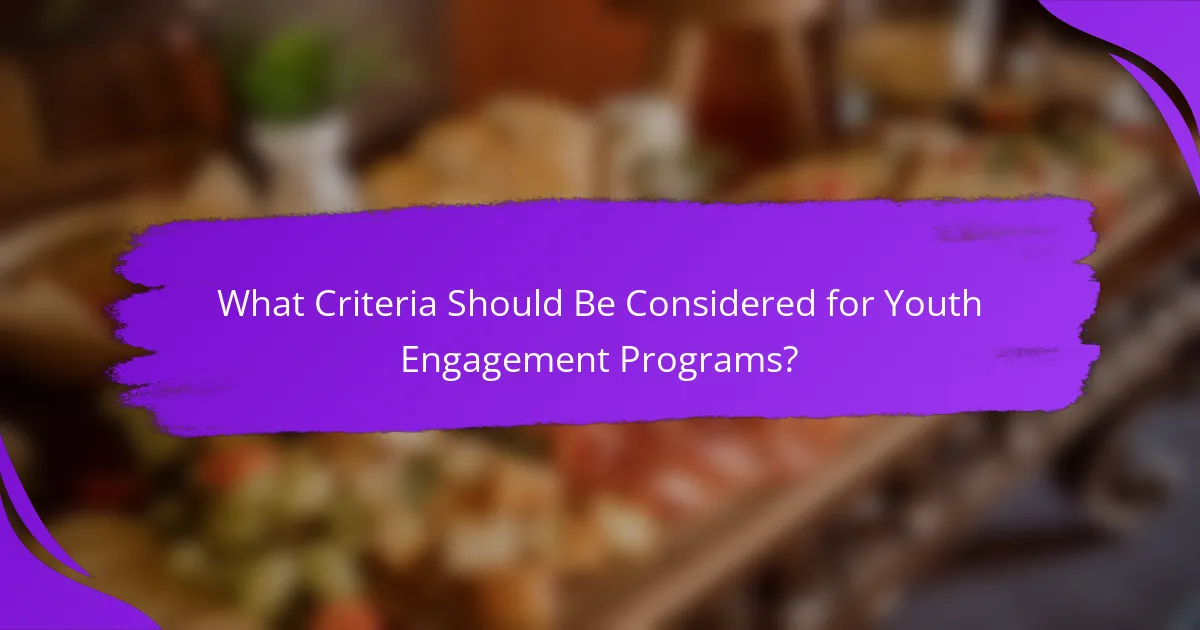
What Criteria Should Be Considered for Youth Engagement Programs?
Effective youth engagement programs should prioritize accessibility, relevance, and partnership opportunities to foster meaningful participation. These criteria ensure that programs resonate with young people and empower them to take active roles in their communities.
Accessibility and inclusivity
Accessibility and inclusivity are crucial for engaging diverse youth populations. Programs should be designed to accommodate varying abilities, backgrounds, and socio-economic statuses. This may include providing transportation, offering materials in multiple languages, and ensuring venues are physically accessible.
Consider implementing online platforms for remote participation, which can help reach youth in rural or underserved areas. Additionally, actively seek input from young people during the planning stages to identify specific barriers they face.
Relevance to youth interests
Programs must align with the interests and passions of young people to maintain engagement. Conduct surveys or focus groups to gather insights on what topics resonate most with your target audience, such as environmental issues, social justice, or mental health.
Incorporating popular culture, technology, and current events can make programs more appealing. For instance, using social media campaigns to promote initiatives can attract youth who are already active online.
Partnership opportunities
Building partnerships with local organizations, schools, and businesses can enhance youth engagement programs. Collaborations can provide additional resources, expertise, and networks that benefit participants. Consider reaching out to community leaders who share a commitment to youth empowerment.
Establishing mentorship programs with professionals in relevant fields can also inspire young people. These partnerships can create pathways for skill development and future career opportunities, making the engagement experience more valuable.

What Are Some Successful Youth Activism Examples?
Youth activism has seen numerous successful examples that highlight the power of young voices in driving social change. From climate action to social justice movements, these initiatives demonstrate how engaged youth can influence policy and public opinion.
Climate Strikes
One of the most notable examples of youth activism is the global climate strikes initiated by young activists like Greta Thunberg. These strikes mobilized millions of students worldwide, urging governments to take immediate action against climate change. The movement emphasizes the urgency of addressing environmental issues and has led to increased awareness and policy discussions in many countries.
To participate effectively, youth can organize local strikes, collaborate with schools, and engage with community leaders. Utilizing social media platforms can amplify their message and connect with like-minded individuals, fostering a larger movement.
Gun Control Advocacy
Following tragic school shootings, youth-led movements advocating for gun control have gained significant traction. Organizations like March For Our Lives, founded by survivors of the Parkland shooting, have successfully mobilized young people to demand legislative changes regarding firearm regulations.
Effective strategies include organizing rallies, lobbying local representatives, and using social media to raise awareness. Engaging in discussions about gun safety and sharing personal stories can resonate with a broader audience, encouraging community support for change.
Social Justice Movements
Youth involvement in social justice movements has been pivotal in addressing issues like racial inequality and police reform. The Black Lives Matter movement, for instance, has seen substantial participation from young activists who use their platforms to advocate for systemic change.
To contribute, young people can educate themselves on social justice issues, participate in peaceful protests, and support local organizations working towards equality. Building coalitions with diverse groups can enhance their impact and foster a more inclusive dialogue.


